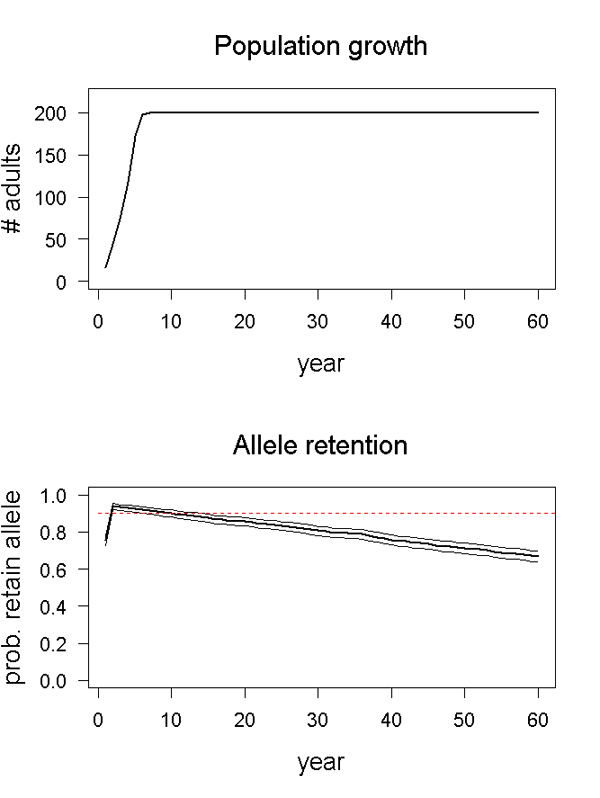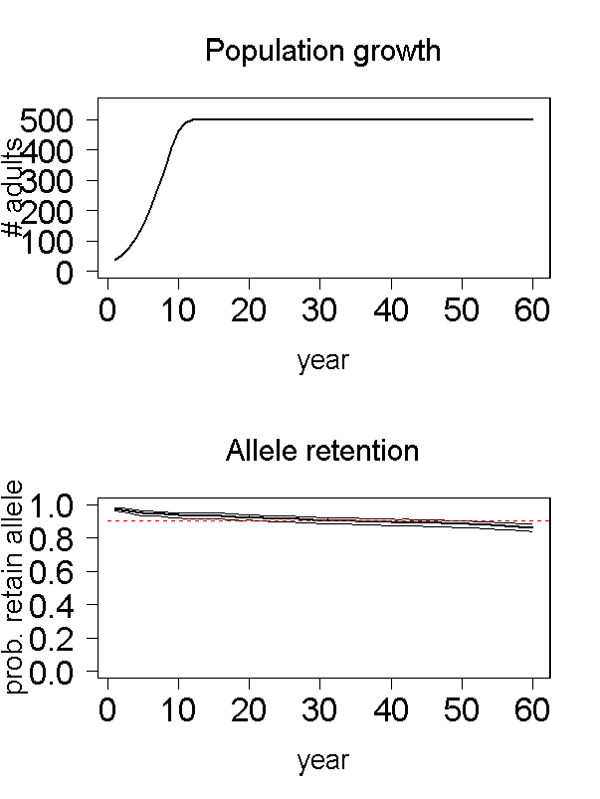First determine your habitat connectivity, habitat size and predator control levels of the translocation site; then view the predicted success of translocations for different scenarios.
Points to note if you are translocating this species
North Island robins prefer mature forest with deep leaf litter, but also use exotic plantations and mature scrub.
There is some indication that translocations are more successful in terms of survival if the source site and destination site have similar habitat types (e.g. mature native forest to mature native forest rather than pine forest to native forest).
There is also greater success when the destination site has similar (or fewer) predator types to the source site because some populations become naive to predators (e.g. islands to islands rather than islands to unfenced mainland sites).
The data for this species were obtained from productive mainland and island populations, making the projections optimistic.
It is usually preferable to perform a single translocation for this species, but translocations are sometimes undertaken in two or more consecutive years. There is some evidence that follow-up translocations are less successful but it likely depends on the site. For example, if your release site is large, there will be plenty of space for any birds that are released in follow-up translocations to avoid resident birds from the first translocation and establish their own territories; however, if your release site is small, any birds that are released in follow-up translocations will be more likely to encounter resident birds, which could make them more prone to dispersal or stress-related mortality.
See Best practice techniques for the translocation of North Island robins (Petroica longipes), South Island robins (P. australis australis) and Stewart Island robins (P. a. rakiura).
Factors of success for North Island robin
Founder number for maximising genetic diversity
60 or 30+30
Habititat connectivity
Low (isolated)
North Island robins are likely to remain at your release site and establish a viable population if there is low habitat connectivity. They are reluctant to cross unsuitable habitat (e.g. juvenile robins are reluctant to fly across > 110 m of open ground or water) and so there will be minimal loss of individuals to dispersal when the habitat is isolated, increasing their likelihood of encountering a mate or benefiting from predator control at the site
Medium
Translocations to sites with medium connectivity have been successful (e.g. Tawharanui Regional Park), although juvenile dispersal from some sites has been high.
High (adjoining)
Translocations to adjoining habitats have had mixed results – some have experienced high dispersal and translocation failure whereas others have succeeded. For example, translocations to the Rimutaka Forest Park water catchment failed due to the dispersal of translocated birds, but translocations to Ark in the Park in the Waitakere Ranges have succeeded.
Habitat size
Small: (minimum area). c.100 ha.
Medium: c.200 ha.
Large: (maintain genetic diversity). c.500 ha.
Minimum predator control
If you are translocating North Island robins, you will need to maintain predators at a low density at the release site at a minimum. However, overall survival and productivity will probably be higher at sites where predators are eradicated or maintained at zero density.
Predators maintained at low density
Rat control is essential over the breeding season to ensure female and egg/chick/juvenile survival. Tracking tunnel indices for rats should be ≤ 5% over the breeding season. Best practice mustelid and cat control is also recommended.
Predators eradicated
This requires the total eradication of all target predators with the exception (in most cases) of mice or the maintenance of zero density year-round.
Predicted success for scenarios
North Island robin: Scenario 1
Scenario: Low habitat connectivity, small habitat size, predators maintained at low density.
Data source: This projection was based on the highest level of mainland productivity and survival.
Conditions: 30 birds were translocated in year one followed by a further 30 in year two; the carrying capacity of the site was 200 robins; there was no migration.
Outcome: A viable population will likely establish, but some genetic diversity will be lost over ten generations due to the low carrying capacity of the site, which may affect the long-term persistence of the population. You could improve this result by choosing a larger site (see Scenarios 3 and 5).
North Island robin: Scenario 2
Scenario: Low habitat connectivity, small habitat size, predators eradicated.
Data source: This projection used data from an island.
Conditions: 30 birds were translocated in year one followed by a further 30 in year two; the carrying capacity of the site was 200 robins; there was no migration.
Outcome: A viable population will likely establish, but some genetic diversity will be lost over ten generations due to the low carrying capacity of the site, which could affect the long-term persistence of the population. You could improve this result by choosing a larger site (see Scenarios 4 and 6).
North Island robin: Scenario 3
Scenario: Low habitat connectivity, medium habitat size, predators maintained at low density.
Data source: This projection was based on the highest levels of mainland productivity and survival.
Conditions: 60 birds were translocated in year one; the carrying capacity of the site was 500 robins; there was no migration.
Outcome: A viable population will likely establish and 80–90% of genetic diversity will be maintained over ten generations. This improvement on Scenario 1 results from the larger area of suitable habitat.
North Island robin: Scenario 4
Scenario: Low habitat connectivity, medium habitat size, predators eradicated.
Data source: This projection used data from an island.
Conditions: 60 birds were translocated in year one; the carrying capacity of the site was 500 robins; there was no migration.
Outcome: A viable population will likely establish and 80–90% of genetic diversity will be maintained over ten generations. This improvement on Scenario 2 results from the larger area of suitable habitat.
North Island robin: Scenario 5
Scenario: Low habitat connectivity, large habitat size, predators maintained at low density.
Data source: This projection used data from sites with the highest levels of mainland productivity and survival.
Conditions: 30 birds were translocated in year one followed by a further 30 in year two; the carrying capacity of the site was 1000 robins; there was no migration.
Outcome: A viable population will likely establish and 90% of genetic diversity will be maintained over ten generations.
North Island robin: Scenario 6
Scenario: Low habitat connectivity, large habitat size, predators eradicated.
Data source: This projection used data from an island.
Conditions: 30 birds were translocated in year one followed by a further 30 in year two; the carrying capacity of the site was 1000 robins; there was no migration.
Outcome: A viable population will likely establish and 90% of genetic diversity will be maintained over ten generations.
North Island robin: Scenario 7
Scenario: High habitat connectivity, medium habitat size, predators maintained at low density.
Data source: This projection used data from sites with the lowest levels of mainland productivity and survival.
Conditions: 40 birds were translocated in year one; the carrying capacity of the site was 500 robins; there was no migration.
Outcome: Dispersal can be a significant issue at highly connected sites. No graphs are presented here because the outcomes were extremely variable, ranging from complete failure (extinction of the population) to establishment. In such a scenario, you will need to undertake intensive monitoring to determine whether your translocation has been successful and how many founders contributed to your population.
North Island robin: Scenario 8
Scenario: High habitat connectivity, large habitat size, predators maintained at low density.
Data source: This projection was based on the highest levels of mainland productivity and survival.
Conditions: 60 birds were translocated in year one; the carrying capacity of the site was 1000 robins; there was no migration.
Outcome: Dispersal can be a significant issue at highly connected sites. Outcomes were extremely variable, ranging from complete failure to establishment. Although the results suggest that translocation led to a successful established population, you would need to undertake intensive monitoring to determine the actual outcome at your site.







